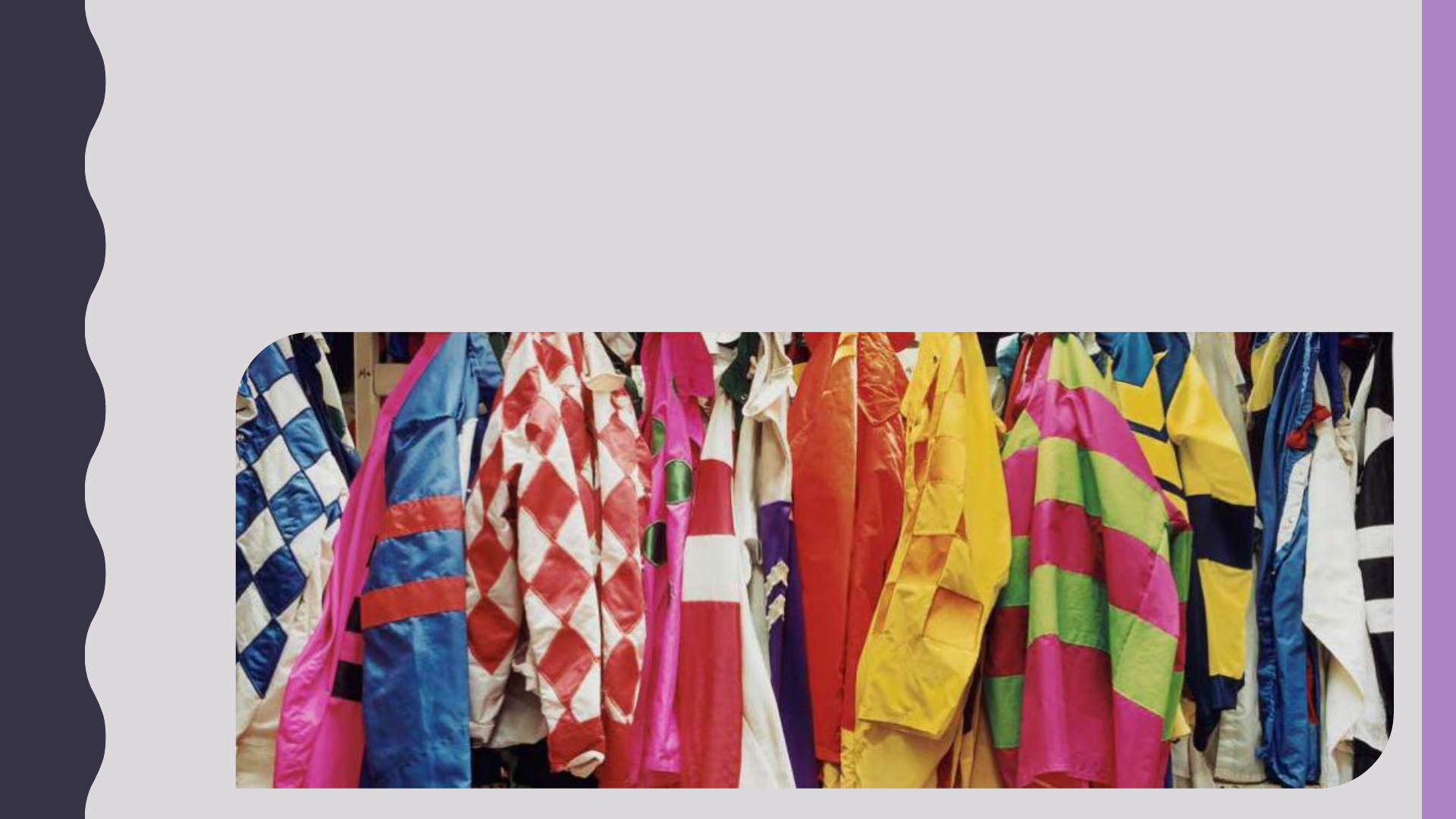
RACING SILKS
A MULTI- DISCIPLINARY LESSON ON
DESIGN FOR K – 12
TH

WHAT ARE RACING SILKS?
Silks are the uniform that a jockey wears during a race. The colorful jackets help
the race commentator and the fans identify the horses on the track.

WHO DECIDES WHAT THE SILKS LOOK
LIKE?
• The horse owner designs the silks.
• Jockeys change their silks each race to reflect
the owner of the horse they will be riding.
• When you see two of the same silks in one
race, that means that both of the horses
belong to the same owner.
• Each silks design is registered with the Jockey
Club so that no two owners have the same
silks. This ensures that each design is unique.

A FEW JOCKEY CLUB DESIGN RULES
• It costs $100 per year to register your silks. You must renew the registration
annually. Colors are renewable on December 31
st
of the year they are
registered.
• Front and back of silks must be identical, except for the seam design.
• Navy blue is NOT an available color.
• A maximum of two colors is allowed on the jacket and two on the sleeves for
a maximum of four colors.
• You may have an acceptable emblem or up to three initials on the ball, yoke,
circle or braces design. You may have one initial on the opposite shoulder of
the sash, box frame or diamond design.

COLORS AND PATTERNS
Silks can be made up of a wide variety of colors and shapes, with patterns like circles, stars, squares,
and triangles. We know colors and patterns mean things, and sometimes horse owners draw
inspirations for their design from their childhood, surroundings, favorite things, and careers.

13
BANNER
FLAGS
High above the
Great Hall in the
Kentucky Derby
Museum, you will
see 13 banners
suspended that
represent the silks
of 13 very special
horses.
§ Can you guess what they
were able to accomplish?

1948 Citation-Calumet Farm
• Warren Wright’s Calumet Farm silks
were one of the most recognized in
racing history
• 8 Derby winners wore them
• 2 of the 8 went on to win the Triple Crown
• 1941 Whirlaway & 1948 Citation
• Silks colors reflect the colors on the can
of the baking powder that made the
Wright family fortune
MEANING BEHIND THE COLORS AND
PAT T E R N S

1978 Affirmed-Harbor View Farm
• Owner Lou Wolfson’s farm was in Florida,
a state known for its large population of
coastal flamingoes
• Silks colors reflect the natural colors of
the flamingo: pink, white and black
• Affirmed was the 1978 Triple Crown
Winner
• Only 13 horses have won the Triple Crown
MEANING BEHIND THE COLORS AND
PAT T E R N S

2007 Street Sense-Jim Tafel
• Owner Jim Tafel’s horse racing silks
inspired his son to use the same colors
for his car racing business
MEANING BEHIND THE COLORS AND
PATTERNS

2005 Giacomo-Jerry & Anne Moss
• The Moss family’s interest in meditation
and Eastern spirituality led to their color
selection
• Teal=color of the heart chakra (green) +
divinity (white)
• Pink=color of protection (red) + divinity
(white)
• The pink band design represents a ring of
protection for the jockey
MEANING BEHIND THE COLORS AND
PATTERNS

1998 Real Quiet-Mike Pegram
• Owner Mike Pegram made his money by
owning McDonald’s franchises. He used
his own initials on the design
• Silks colors reflect the colors of
McDonald’s which are red and yellow
MEANING BEHIND THE COLORS AND
PATTERNS

BRAINSTORM YOUR SILKS DESIGN
• Look around the room. Do you see any colors or shapes in the
room that can inspire you?
• What would you name your Derby horse?
– Can you associate any colors or shapes with that name?
• What colors and shapes are important to you, your family, your
friends, or your culture?
• Silks colors can remind you of important people or things in life.
– What is your mom’s favorite color?
– What color is the house you live in?
• The colors and shapes you choose for your silks can represent
shared cultural meaning.
– What are the colors and shapes on your country’s flag?
– What is your favorite holiday?

Writing Prompt Challenge: Imagine you
are submitting your silks to the Jockey Club for
approval. Write a one page description that
explains your design and color selections. Be
creative!
Core Academic Standards:
(Writing) C.2.3, L.2.1, L.2.2, C.3.1, C.3.2, C.4.2, L.4.3, C.5.3, C.6.3, L.6.2, C.7.3, L.7.2, C.8.3, C.9-10.3, L.9-10.2, C.11-12.2,
L.11-12.2
(Art) VA:Re7.2.K, VA:Pr7.1.1, VA:Cr1.2.1, VA:Cr1.1.2, VA:Cr1.1.3, VA:Re7.2.3, VA:Re7.2.4, VA:Pr7.1.5, VA:Pr7.1.6, VA:Re8.1.7,
VA:Pr7.1.8
